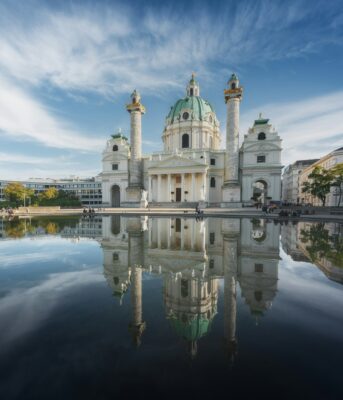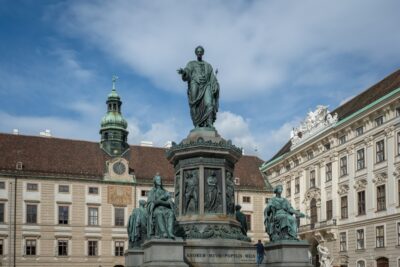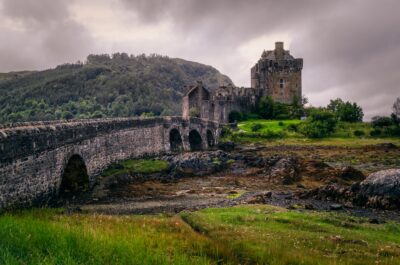Did you know that over 1.9 million people call Vienna home? This vibrant city, often ranked as one of the most livable in the world, has a story that spans over 2,000 years. Once a Roman military camp named Vindobona, Vienna has evolved into a cultural powerhouse.
At the heart of Vienna’s identity is its rich past. The city’s coat of arms still features the double-headed eagle, a symbol of its imperial legacy. From its early days as a Roman settlement to its rise as the capital of the Austrian Republic, Vienna has been a place where time stands still.
Vienna’s journey from a humble military outpost to a thriving cultural center is nothing short of remarkable. This guide will explore how Vienna became the hub of trade and culture it is today. Whether you’re a history buff or a culture enthusiast, Vienna’s story will captivate you.
So, dive into this ultimate guide to uncover the layers of Vienna’s past and present. Let’s explore how this city’s history and culture have shaped its vibrant spirit.
Introduction to Vienna’s Rich Heritage

Vienna, a city steeped in legacy, traces its roots back thousands of years. The first settlers, Celts, laid the groundwork for what would become a thriving metropolis. In 15 BCE, the Romans established Vindobona, a military camp that would evolve into a vital center.
Over the centuries, Vienna grew under various empires. The Holy Roman Empire and later the Austro-Hungarian Empire left lasting imprints. Each period added layers to the city’s identity, shaping it into a cultural and political hub.
Today, Vienna stands as a testament to its past. Its heritage is a blend of Roman foundations, medieval growth, and imperial grandeur. This rich tapestry continues to inspire, making Vienna a city where history and modernity coexist harmoniously.
The History and Culture of Vienna, Austria
Vienna’s journey from a Roman military camp to a cultural capital is a story of transformation. Over the centuries, this city has been shaped by powerful families and ruling dynasties. The Babenbergs and Habsburgs played key roles, turning Vienna into a center of power and culture.
Wars, especially those with the Ottoman Empire, left lasting impacts. The Holy Roman Empire also influenced Vienna’s growth. By the 19th century, Vienna became a capital known for its grandeur and artistic achievements. Today, it stands as a vibrant international center.
The city’s history is marked by cultural milestones. From its early trade networks to its modern innovations, Vienna has always been a place of change. Its transformation into a global hub highlights its enduring legacy.
- Vienna’s evolution from a military outpost to a cultural capital.
- The role of ruling families in shaping its prestige.
- Wars and governance shifts that defined its path.
- Cultural milestones that showcase its vibrant spirit.
Roman Roots & Celtic Beginnings
Long before Vienna became the vibrant city we know today, its story began with the Celts. These early inhabitants settled in the area around 500 BCE, establishing a thriving community along the Danube River. The Celts brought their unique culture and trade networks, laying the groundwork for what would later become a major urban center.
Vindobona: The Roman Military Camp
In the 1st century, the Romans arrived, transforming the area into a strategic military outpost called Vindobona. This camp, occupied by the Legio X Gemina, played a crucial role in protecting the empire’s borders. Today, remnants of this ancient past can still be seen in Vienna’s city center. Archaeological discoveries, such as the ruins at Michaelerplatz and fragments of Roman walls, offer a glimpse into the city’s Roman heritage.
Celtic Influences in Early Vienna
Although the Romans left a lasting impact, the Celtic influence remained a significant part of Vienna’s identity. The early Celtic settlements and the Roman military camp together shaped the city’s early development. These foundations not only influenced the urban layout but also laid the groundwork for Vienna’s future as a center of power and culture.
Babenberg Dynasty: Foundations of a Capital
The Babenberg Dynasty played a pivotal role in shaping Vienna’s future as a capital. Their rule marked the beginning of Vienna’s transformation into a central hub of power and culture.
Early Trade and Economic Growth
Duke Henry II’s declaration of Vienna as the capital in 1155 was a turning point. This move spurred economic growth, leveraging Vienna’s strategic location on the Danube River. The establishment of staple ports and city rights attracted merchants, boosting trade and commerce. The capture of King Richard the Lionheart in 1192, while tragic, unexpectedly benefited Vienna, as his ransom funded significant developments.
Cultural Milestones under Babenberg Rule
Under Babenberg rule, Vienna saw the construction of city walls and mints, symbols of its growing importance. These infrastructure projects laid the foundation for future cultural flourishing, setting the stage for Vienna to become the vibrant capital it is today.
Habsburg Era: Imperial Ambitions and Artistic Flourishing
The Habsburg dynasty’s rise marked a transformative period for Vienna, turning it into a vibrant imperial and artistic hub. This era laid the foundation for the city’s modern identity, blending grandeur with cultural richness.
Rudolf IV and the Founder Legacy
Rudolf IV, known as the Founder, played a crucial role in shaping Vienna’s future. In 1365, he established the University of Vienna, one of the oldest in Europe. His vision extended to monumental constructions, such as the Gothic nave at Stephansdom, which became symbols of the city’s architectural prowess.
Imperial Patronage of the Arts
Under Habsburg rule, Vienna flourished as a center for arts and education. The emperors were avid patrons, supporting artists and architects who left lasting legacies. This patronage created an environment where creativity thrived, making Vienna a beacon of cultural innovation.
The Habsburgs’ contributions were not just artistic. They implemented reforms and urban developments that transformed Vienna into a modern capital. Their leadership set the stage for the city to become a global center of culture and learning.
Architectural Marvels: From Romans to the Ringstraße
Vienna’s architectural landscape tells a story of evolution and innovation, shaped by centuries of diverse influences. From ancient Roman ruins to the grand Ringstraße boulevard, the city’s built environment reflects its rich history and cultural shifts.
Ancient Ruins and Medieval Fortifications
Remnants of Roman military structures still stand today, like the archaeological site at Michaelerplatz. These ancient walls echo the city’s strategic importance as a military outpost. As Vienna grew, medieval fortifications replaced Roman structures, adapting to the needs of a expanding urban center.
Baroque Splendor and Jugendstil Innovations
The 17th and 18th centuries brought Baroque architecture, with grand palaces like Schönbrunn and Belvedere showcasing imperial grandeur. The 19th century saw the rise of Jugendstil, with iconic buildings like the Secession Building and St. Leopold Church, blending tradition with modernity.
The demolition of medieval walls in the 19th century led to the creation of the Ringstraße, a monumental boulevard lined with Neo-Renaissance and Neo-Gothic buildings. This transformation symbolized Vienna’s emergence as a modern capital, blending historical elegance with contemporary design.
Each architectural era left its mark, creating a cityscape where past and present coexist. From Roman ruins to Baroque palaces and Jugendstil innovations, Vienna’s architecture is a testament to its enduring legacy as a center of cultural and artistic expression.
Vienna as a Cultural Hub for Music and the Arts
Vienna’s reputation as a global center for music and arts is unmatched. For centuries, this city has been a magnet for creative minds, earning it the nickname “City of Music.” From classical masterpieces to modern design, Vienna continues to inspire artists and audiences alike.
Classical Composers and Musical Heritage
Vienna’s musical legacy is profound. Composers like Mozart, Beethoven, and Strauss once called this city home. Their works remain the cornerstone of classical music. The city’s concert halls and opera houses, such as the Vienna State Opera, keep this tradition alive, offering performances that attract music lovers worldwide.
Modern Design and Innovation in the Arts
Today, Vienna is also a hotspot for contemporary art and design. Museums like the Museum of Applied Arts (MAK) and design studios showcase cutting-edge creativity. The city’s modern architecture, blending seamlessly with historic landmarks, reflects its commitment to innovation. This fusion of old and new makes Vienna a vibrant hub for both historical and contemporary art.
Imperial patronage played a significant role in shaping Vienna’s artistic identity. Emperors supported the arts, fostering an environment where creativity thrived. This legacy is preserved in the city’s galleries and museums, ensuring that Vienna remains a center of cultural excellence.
Medieval to Modern: City Fortifications and Turkish Sieges 
Vienna’s journey from medieval fortifications to modern defenses is a story of resilience. The city’s strategic location made it a target for invaders, leading to the development of strong defensive systems.
Defensive Walls and Strategic Battles
During the medieval period, Vienna built thick walls to protect against invaders. These walls were crucial during the Turkish sieges of 1529 and 1683. In 1529, the city successfully repelled the first Turkish attack, thanks to its strong defenses. The second siege in 1683 was more intense, but Vienna’s improved fortifications held firm, marking a turning point in its history.
The defensive strategies used in these battles were vital. The city’s walls and the bravery of its defenders ensured Vienna’s survival. These events shaped the city’s identity as a resilient and strategic center.
- Medieval walls were built to protect Vienna from invaders.
- The Turkish sieges of 1529 and 1683 tested the city’s defenses.
- Vienna’s successful defense in 1683 was a significant moment in its history.
- These events highlight the city’s strategic importance and resilience.
Vienna’s ability to adapt its defenses over centuries shows its evolution from a medieval fortress to a modern city. These historical events remain important in understanding Vienna’s role as a political and military center.
The Napoleonic Impact and the Congress of Vienna
Napoleon’s influence left a lasting mark on Vienna, particularly during his two occupations in 1805 and 1809. These events disrupted the city’s political and social structures, leading to significant changes. The Battle of Wagram in 1809, though a French victory, strained Vienna’s defenses, prompting local leaders to rethink their military strategies.
In 1814, Vienna became the center of European diplomacy. The Congress of Vienna, attended by prominent figures like Metternich and Talleyrand, aimed to restore order after the Napoleonic Wars. This gathering redrew Europe’s political map, establishing a balance of power that lasted for decades. The Congress not only reshaped the continent but also solidified Vienna’s role as a diplomatic hub.
- Napoleon occupied Vienna twice, affecting its governance and economy.
- The Battle of Wagram highlighted the need for stronger defenses.
- The Congress of Vienna in 1814-15 restructured Europe’s political landscape.
- Eminent leaders gathered to negotiate peace and future governance.
- These events marked a shift from conflict to organized diplomacy.
This period was a turning point for Vienna, transitioning from a war-torn city to a seat of international diplomacy. The Congress of Vienna’s legacy endures, shaping both the city’s and Europe’s modern identity.
Vienna’s Industrialization and Urban Expansion
Vienna’s transformation from a military outpost to a bustling metropolis is a story of remarkable growth and innovation. By the 19th century, the city began to shed its medieval fortifications, embracing industrialization and urban development.
The Transition from Fortress to Metropolis
The dismantling of Vienna’s old walls in 1858 marked the beginning of a new era. This change allowed for the creation of the iconic Ringstraße, a grand boulevard that symbolized the city’s modern aspirations. The regulation of the Danube River further supported this growth, preventing floods and enabling construction along its banks.
Industrialization brought rapid change. Factories and railways emerged, connecting Vienna to other European cities. This period also saw the incorporation of surrounding suburbs, expanding the city’s boundaries and population. By the early 20th century, Vienna had become a center of innovation, with its population swelling to over two million by 1914.
- The removal of medieval walls made way for modern infrastructure.
- Industrial growth and railway networks connected Vienna to Europe.
- Suburbs were incorporated, expanding the city’s size and population.
- Economic growth and immigration fueled this transformation.
By the mid-20th century, Vienna had evolved into a thriving metropolis, blending its rich history with modern advancements. This period of industrialization and urban expansion set the stage for Vienna to become the vibrant city it is today.
Revolution and Social Change in the First Republic
The early 20th century brought dramatic shifts to Vienna, marking a period of revolution and social reform. Following the end of World War I, the city faced significant political and social unrest.
In 1918, the January Strike highlighted the growing tensions among workers, leading to widespread protests. These events set the stage for the establishment of the First Republic, a new political order that sought to redefine Vienna’s identity.
During this time, revolutionary ideas inspired major urban and social reforms. The city became a center for progressive policies, particularly in housing. The construction of Gemeindebauten, or social housing projects, transformed districts across Vienna, offering affordable living spaces for thousands of residents.
These communal housing initiatives became international models, showcasing Vienna’s commitment to social equity. The challenge of rebuilding after the war was immense, but the city’s focus on civic development laid a strong foundation for the future.
The impact of these reforms is still evident in Vienna’s modern social policies and government administration. They remain a cornerstone of the city’s identity, reflecting its dedication to creating a more just and equal society.
Post‐War Recovery and International Diplomacy

After the devastation of World War II, Vienna faced a long road to recovery. The city, once a thriving metropolis, lay in ruins, its infrastructure severely damaged. The Allied forces occupied Vienna, dividing it into four zones controlled by the United States, Soviet Union, France, and Britain. This period of occupation lasted until 1955 when Austria regained its sovereignty through the Austrian State Treaty.
From Occupation Zones to Global Conferences
The post-war era marked a significant transformation for Vienna. The city shifted from a war-torn capital to a hub of international diplomacy. The establishment of major international organizations, such as the United Nations, transformed Vienna into a global center for diplomacy. The city’s neutral political stance during the Cold War made it an ideal location for international conferences and negotiations.
Vienna’s cultural identity remained strong despite the challenges of reconstruction. The city continued to be a center for music and the arts, preserving its rich heritage. This cultural continuity played a crucial role in shaping Vienna’s new identity as a modern, cosmopolitan city.
By the late 20th century, Vienna had emerged as a vibrant international center. The city’s successful transition from post-war recovery to a hub of global diplomacy marked the beginning of a new era. Today, Vienna stands as a testament to resilience and diplomacy, blending its historical legacy with modern innovation.
Contemporary Vienna: Balancing Heritage with Modernity
Modern Vienna seamlessly blends its rich historical legacy with cutting-edge innovation, creating a unique urban environment. This vibrant city continues to evolve, embracing new technologies while preserving its cultural treasures.
Urban Renewal and Technological Innovation
Vienna’s urban renewal projects are a prime example of how the city maintains its heritage. For instance, the revitalization of historic buildings along the Danube Canal combines modern design with preserved facades. These efforts ensure that landmarks remain relevant in the 21st century.
Technological advancements are also transforming daily life in Vienna. The city’s public transportation system is one of the most efficient in the world, integrating smart traffic management and renewable energy solutions. Digital initiatives, such as mobile apps for city services, enhance residents’ and visitors’ experiences.
Vienna’s cultural scene thrives through a mix of traditional and contemporary art. Museums like the MAK – Museum of Applied Arts, showcase both historical artifacts and modern installations. This blend attracts a diverse audience, keeping the city’s artistic spirit alive.
Comparisons with global cities like New York highlight Vienna’s unique approach to modern governance. While maintaining its historical charm, Vienna adapts international trends to suit its identity. This dynamic balance ensures the city remains a center for innovation and culture.
Local Culture: Traditions, Cuisine, and Coffee House Legacy
Vienna is a city where tradition and modernity blend seamlessly, offering a unique cultural experience. The heart of this vibrant city beats with charming local customs, iconic cuisine, and an unparalleled coffee house culture that has been cherished for centuries.
Viennese Coffee House Culture and Culinary Delights
Step into a traditional Viennese coffee house, and you’re stepping into a time capsule. These iconic establishments have preserved the timeless charm of a bygone era. Comfortable seating, elegant interiors, and the aroma of freshly brewed coffee create an inviting ambiance. It’s where locals and visitors alike gather to enjoy a leisurely cup of coffee and delicious pastries like the famous Sachertorte.
Viennese cuisine is a delightful journey through flavors and traditions. Dishes like Wiener Schnitzel, Tafelspitz, and Kaiserschmarrn are staples that have been perfected over centuries. Heurigers, cozy wine taverns, offer a taste of local wines and hearty meals, providing a unique glimpse into the city’s culinary heritage.
Today, Vienna’s coffee houses continue to be vibrant social hubs, much like the historic salons where intellectuals once gathered. These modern-day cafés maintain the essence of their predecessors, offering a space for both relaxation and intellectual discourse. Whether you’re indulging in a traditional coffee or exploring contemporary culinary innovations, Vienna’s cultural scene is sure to captivate.
Experience the soul of Vienna by immersing yourself in its rich traditions. From the grandeur of its coffee houses to the warmth of its culinary delights, the city invites you to savor every moment of its enduring legacy. Let the charm of Vienna’s local culture leave you with unforgettable memories.
Experiencing Vienna: Museums, Landmarks, and District Discoveries
Step into Vienna, a city where every corner tells a story. This vibrant metropolis invites you to explore its iconic landmarks, hidden gems, and cultural neighborhoods. Whether you’re a history enthusiast or a curious traveler, Vienna offers a wealth of experiences that bring its past and present to life.
Iconic Sites and Hidden Gems
Start your journey in the heart of the city at Stephansdom, a Gothic masterpiece that has watched over Vienna for centuries. Stroll along the Ringstraße, where grand monuments like the State Opera House and Parliament Building showcase the city’s architectural splendor. These landmarks are not just tourist attractions; they are living pieces of Vienna’s history.
Cultural Districts and Neighborhood Stories
Wander through Vienna’s diverse districts, each with its own unique character. In the Museum District, world-class institutions like the Kunsthistorisches Museum and Naturhistorisches Museum await, offering insights into art, science, and culture. Explore the charming neighborhoods of Grinzing or Neubau, where local traditions and modern life intertwine. Every district reveals a new layer of Vienna’s multifaceted history, making the city a living museum of experiences.
From the grandeur of its landmarks to the warmth of its neighborhoods, Vienna is a city that captivates the senses. Let your journey through its museums, landmarks, and districts be a testament to its enduring legacy as a cultural and historical treasure.
Conclusion
From its humble beginnings as a Roman military camp to its current status as a modern metropolis, Vienna stands as a testament to resilience and innovation. Over the centuries, this city has transformed through Roman foundations, medieval growth, and imperial grandeur, each era leaving its mark. Today, Vienna thrives as a vibrant city where tradition and modernity coexist harmoniously.
The journey from a military outpost to a cultural hub highlights Vienna’s enduring legacy. The city’s past continues to shape its present, blending historical elegance with contemporary design. This interplay between old and new invites reflection on how tradition and innovation can flourish together.
Vienna’s evolution is a story of collective effort and creativity. Every person and place has contributed to its identity, making it a city where history and modernity seamlessly intersect. Whether you’re exploring landmarks, savoring cuisine, or simply soaking in the atmosphere, Vienna offers a unique experience.
Take a moment to visit Vienna and discover its rich tapestry in person. Let the city’s charm inspire you to explore further and uncover more of its hidden gems. Vienna awaits, ready to captivate your senses and leave a lasting impression.
Join Two Travel Gurus for a stress-free travel experience. We handle everything so you can focus on making memories. Visit us here and check out our latest travel guides.






